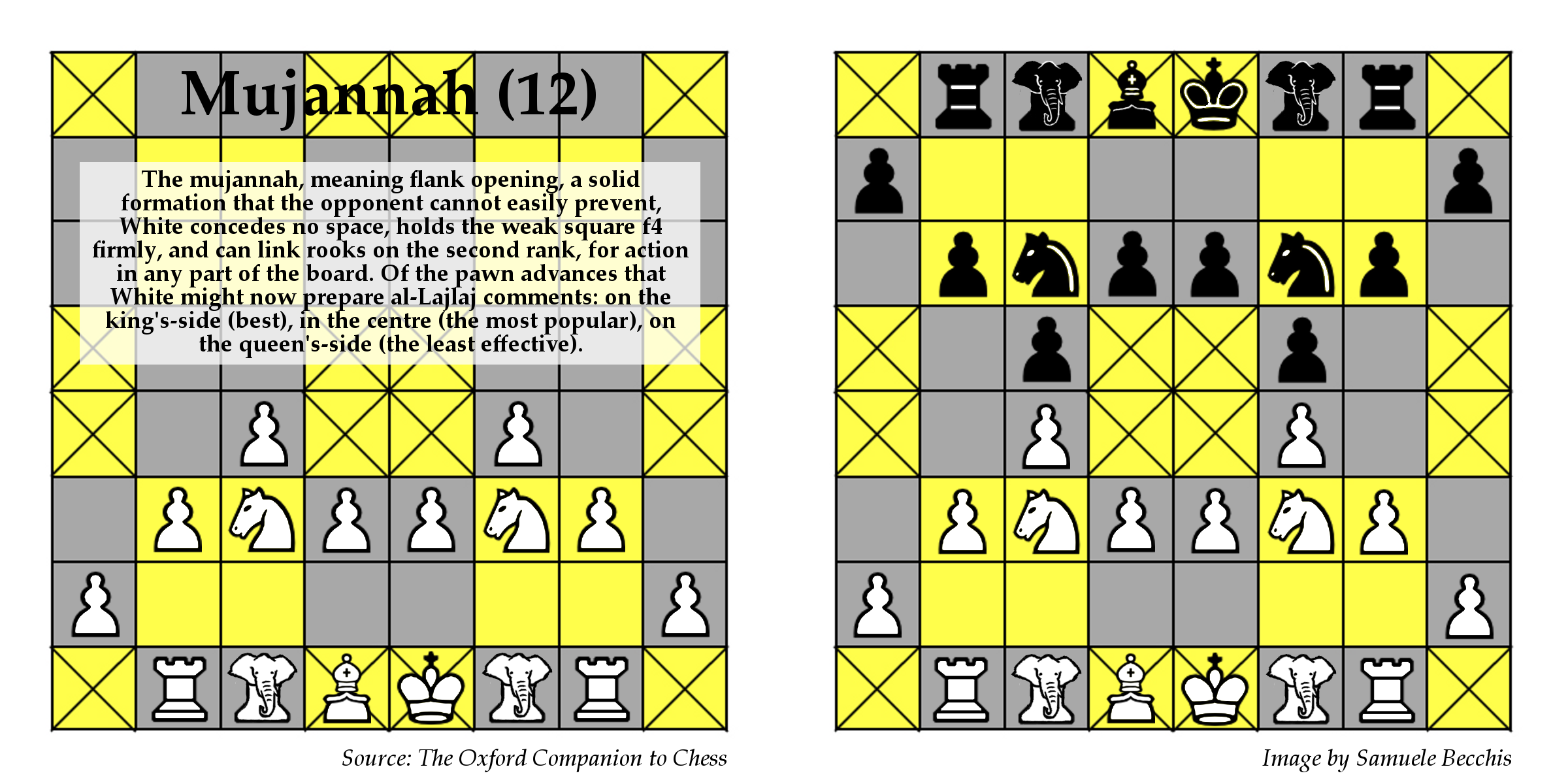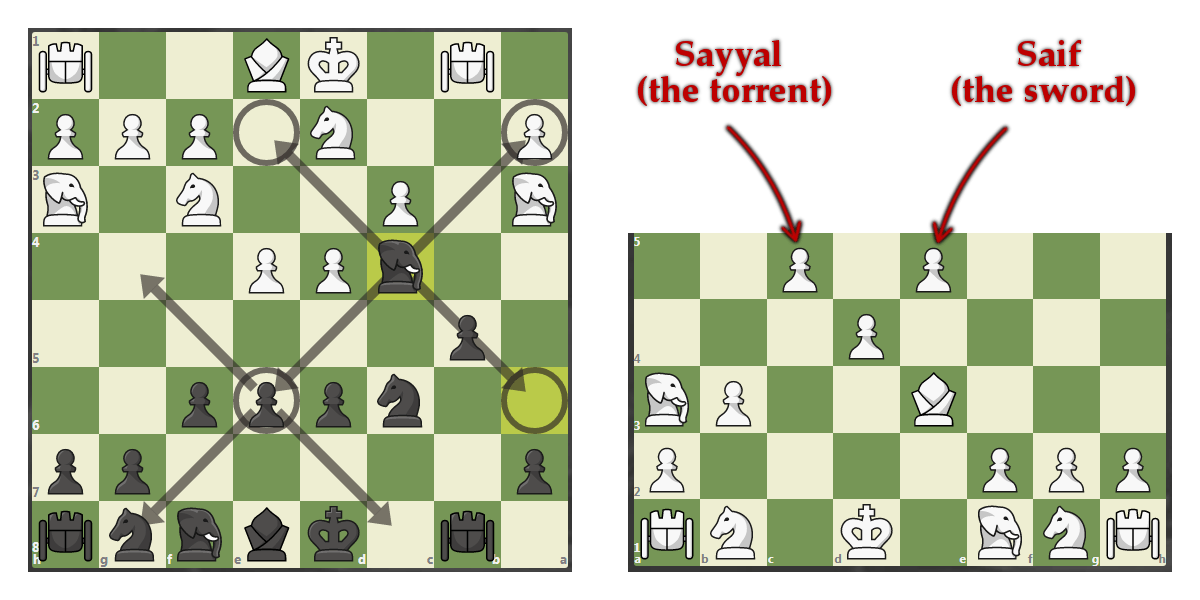So what to do with the Elephants ?
In Western literature they are mostly known as Alfils, from the Arabic 'al-Fil' just meaning 'the-Elephant'. Why to use an Arabic word, isn't this game Indian? Indeed the game originated in India and quickly spread into Persia and Arabia where it was played at a very high professional level, then later in Europe, finally giving birth to modern orthodox Chess. So several Arabic terms survived even in modern Chess literature such as Rook, Alfil, Fers, tabiya, Mujannah ... Therefore I'd like to follow keeping the name 'Alfil'.

Each of the 4 Alfils can only reach 8 squares of the board, different from one another so that no one can capture -- nor protect -- any other. All together they control 32 squares out of 64: no Alfil can reach any central squares, no Alfil can reach any corner squares, 32 squares in total are unreachable to any Alfils (they are gray in my diagram above).
One can be tempted to move them immediately toward the center (in d3 and e3) so giving them more space and mobility, unfortunately this would block the central pawns and likely you will have to move your Alfils back if you want to advance your pawns, so... It's probably better to wait the right moment for the Alfils to develop in the right place.

Really they can already do an excellent job by just sitting in their starting positions, providing a formidable crossed defence in the middle -- assuming to have a backward pawn center in d3 and e3 -- and so giving protection to King and Farzin, both from frontal attacks and side attacks. Definitely a solid formation where our wise King is safe in his 'palace', the center is protected, and the Elephants are ready to support flank attacks on both sides.
Other than that just remember that an Alfil is worth just a bit more than a pawn, so when you exchange it for 2 pawns you're actually getting material advantage, even for only 1 central pawn it's okay, it is not a sacrifice it's just an equal exchange. Sometimes exchanging an Alfil for pawns is the best move to do and it might be a crucial move in order to achieve a positional advantage.

Finally it may be useful to notice that 2 pawns and an Alfil can form a self-defending structure which can be a solid formation for the midgame or a helpful one for the endgame, especially in case you are down in material and need to protect your pieces from the enemy attacks.












Please don't complain about Elephants, just improve your Elephant-play:
"In the weakest pieces you'll find the deepest strategy of this game!"
Definetly Ancient Chess was an analytic game of finely detailed strategy, just as modern Chess I guess, or likely even more. Chessmen had to move 'dancing' on a different music though, since we are going back in time, up to -- at least -- 1500 years ago! Only few pieces moved differently really, and just a few game rules were different, I mean basically it's always Chess, just in its 'primitive' form.
Piece values, according to me, are:
Rook=6,
Horse=4,
Farzin=2,
Alfil=1.5,
central pawn=1.5,
other pawns=1.
Note: when I say 'Horses' I refers to the Knights, while 'Farzin' is the Persian for Minister/ wise man/ counselor/ vizir... Farzin or whatever called: Firzan, Firz, Ferz, Fers or Fersa... I mean that guy next to the King!!
Rooks are the strongest pieces on the board and they strongly define the rythm of the dance, just like a sort of drums. Horses instead are like trumpets and they make great efficient jumps which we already know from standard Chess.
Alfils, weak pieces which take big steps, sometimes just sitting and doing their job 'silently', they seems to be like the basses of our music. A bit apart from the rumble an Alfil (or so-called Elephant) can often survive until the end of the game, or just beeing exchanged in the midgame for a 'good pawn'.
Keeping with the metaphor, I'd say that pawns are like a chorus, while Farzin is like an ancient cithara or maybe a lyre; that's kind of a Bishop but on a smaller 'scale', and it stands alone, without any 'brother' on the opposite-colour squares (unless of a pawn promotion on the right colour)... Well, back in the ages, the chessboard wasn't checkered, but nothing changes in fact it's always an 8x8 grid.
First steps in the opening:
In my usual play pawns go first, this seems to be the most logical thing. Having both Kings set on the d-file, I personally open as first player with c3--d3--e3--f3, followed by b3--c4; and then my Horse (on the kingside) can have a nice development in c3 or d2.
1-2-3-4 steps are kind of universal, while 5 and 6 are a clear approach to my favourite opening: the Mujannah.